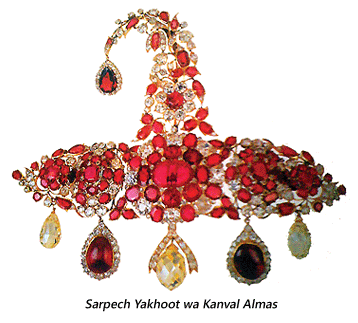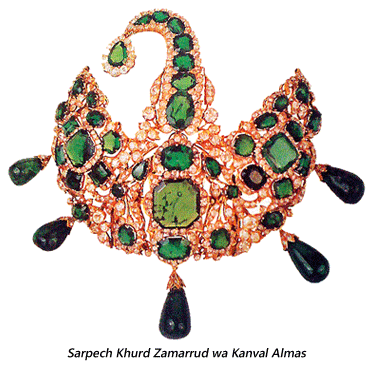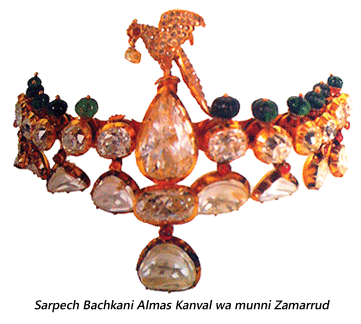- Prelude
- Editorial
- A time to Act
- Raja Ravi Varma: The painter who made the gods human
- Rabindranath as Painter
- Gaganendranath: Painter and Personality
- Abanindranath Tagore: a reappraisal
- Where Existentialism meets Exiledom
- Nandalal Bose
- Jamini Roy's Art in Retrospect
- Sailoz: The Inerasable Stamp
- Amrita Sher-Gil
- Calcutta's Best Kept Secret: The Marble Palace
- Art is Enigmatic
- A few tools to protect the French culture
- The exact discipline germinates the seemingly easiness
- Symbols of Monarchy, power and wealth the Turban Ornaments of the Nizams
- The Bell Telephone
- The Pride of India
- Tapas Konar Visualizing the mystic
- Theyyam
- Our Artists vs. their Artists
- Dragon boom or bubble?
- What Happened and What's Forthcoming
- Art Bengaluru
- Musings from Chennai
- Art Events Kolkata: May – June 2011
- Mumbai Art Sighting
- Previews
- In the News
ART news & views
Symbols of Monarchy, power and wealth the Turban Ornaments of the Nizams
Volume: 3 Issue No: 18 Month: 7 Year: 2011
Jewellery
by Koeli Mukherjee Ghose
The Nizam's collection of jewellery consists of pieces that are of the most exceptional variety of Deccani, Rajasthani and Lucknowi artistry, said to be one of the most valuable collections of Indian jewellery.
The word Nizam is a shortened version of the urdu word Nizam-ul-Mulk, meaning - Administrator of the kingdom. It was the title of the sovereigns of Hyderabad State, belonging to the Asaf Jah dynasty, since 1719, The dynasty was founded by Mir Qamar-ud-Din Siddiqi, he was sent as the viceroy of the Deccan by the Mughal Emperor (1713 1721). The Asaf Jahi dynasty originated in the area about Samarkand, but the family came to India from Baghdad in the late 17th century.Names of five men and one woman is mentioned defining the family, they were direct descendants of the first Khalifa of Islam, Hazrat Abu Baker Al-Siddiq. Seven Nizams ruled Hyderabad for two centuries until India's Independence in 1947.The Asaf Jahi rulers were lovers of literature, art, architecture, culture, jewellery and culinary delicacies (of Persian and Turkish influence).
Note: The lineage of the Nizams is as follows
? Qamar-ud-din Khan Siddiqi, Asaf Jah I : 31 July 1720, 1 June 1748,
? Mir Ahmed Ali Khan Siddiqi, Nizam-ud-Dowlah Nasir Jang : 1 June 1748 : 16 December 1750,
? Nawab Hidayat Mohi-ud-din Sa'adu'llah Khan Bahadur, Muzaffar Jang : 16 December 1750, 13 February 1751,
? Nawab Syed Mohammed Khan Siddiqi, Amir ul Mulk, Salabat Jang : 13 February 1751, 8 July 1762,
? Nawab Mir Nizam Ali Khan Siddiqi Bahadur, Nizam ul Mulk, Asaf Jah II : 8 July 1762, 6 August 1803,
? Nawab Mir Akbar Ali Khan Sikandar Jah Siddiqi, Asaf Jah III : 6 August 1803, 21 May 1829,
? Nawab Mir Farkhonda Ali Khan Siddiqi Nasir-ud-Daulah, Asaf Jah IV: 21 May 1829 16 May 1857,
? Nawab Mir Tahniat Ali Khan Siddiqi Afzal ud Daulah, Asaf Jah V : 16 May 1857, 26 February 1869,
? Fateh Jang Nawab Mir Mahboob Ali Khan Siddiqi, Asaf Jah VI : 26 February 1869, 31 August 1911,
? Fateh Jang Nawab Mir Osman Ali Khan Siddiqi, Asaf Jah VII : 31 August 1911, 24 February 1967,
? Barkat Ali Khan Mukarram Jah, Asaf Jah VIII : 24 February 1967 Present
The present collection of the jewellery includes a total of 173 pieces. They are 325 in number, as individual pieces, when not counted as pairs; moreover there are 22 unset emeralds and the legendary Jacob diamond.  In January 2006, the jewels were Exhibited in the Salar Jung Museum for two months, showcasing the gems and jewelleries from the collection along with the Jacob diamond, Weighing 184.75 carats, seventh largest in the world, this sparkling diamond is double the size of the Koh-i-Noor diamond, the sixth Nizam Mehboob Ali Pasha purchased it from a Jewish trader called A.K. Jacob In 1891.
In January 2006, the jewels were Exhibited in the Salar Jung Museum for two months, showcasing the gems and jewelleries from the collection along with the Jacob diamond, Weighing 184.75 carats, seventh largest in the world, this sparkling diamond is double the size of the Koh-i-Noor diamond, the sixth Nizam Mehboob Ali Pasha purchased it from a Jewish trader called A.K. Jacob In 1891.
These ornaments were part of the Nizam's treasury; Individual pieces of jewellery have been archived by the Government of India Inventory, with reference to their significance, but complete information about the artisans, time, place and most importantly who they were made for, is not available. The deeds of the trust, registers the names of the jewels in Persian and Hindi, in the inventory, the idea of abiding to these elaborate names is with an intention to retain an authentic linguo-historical linkage.
The Nizams ruled the Deccan for 224 years they preserved their loyalty for the Mughals by not emphasising their sovereignty. After Aurangzeb's death, all through the waning of the Mughal Empire, the regional viceroys acknowledged statute, robes of honour, and gifts of jewels from the Emperor.
Gifts of high value such as turban ornaments as sarpatti (sarpech,digha, turra and kalgi), Necklaces referred to as (kanthi,haar,mala) arm bands (bazuband or bhujband, avaralna, bracelets), were received from and also presented to the Emperor.
Usha R. Balakrishnan in the book Jewels of the Nizam, published in 2001, mentions “The Nizams were foreigners in South India, circumstances brought them to a region that they eventually made their home.But for the almost 225 years therefore their lifestyle and their culture were modelled on the Mughal court in Delhi, distinctly different from the indigenous milieu. Nevertheless traits of local influences can be seen in several items including the buckle set with Burmese cabochon rubies and diamonds in style. Reminiscent of hair jewels of south India. Similarly the diamond flower head buttons are in the quintessential form of ear ornaments of the region bearing in mind the history of the Asaf Jah rulers, the earliest items in the collection entered the Hyderabad treasury at the time of the annexation of the Deccan. The Deccan juxtaposed between the Mughal North and the Hindu South together with a revival of Royal patronage, under the Nizams, drew craftsman to Hyderabad from Delhi, Lahore, Haryana, Gujrat, Rajsthan and Lucknow.”
After independence the Maharajas had to sell their valuables and jewelleries for their own sustenance, in this situation the European jewellery firms came in pursuit of the fabulous gems from the royal repositiries. It is known that before 1948, gems and jewels from princely collections were regularly being sold, Hans Nadelhoffer, a jewellery expert for Christies auction house in Geneva,), accounts that in 1912 and 1913, the Nizam of Hyderabad auctioned gemstones and antique weapons and the Gaekwads of Baroda sold pearls and jewels. Nadelhoffer also discuss that in 1931 the London branch of Cartier bought the outstanding olive green diamond originally weighing 17.50, carats supposedly from the collection of the Nizam of Hyderabad. The gem was recut and infused into the legendary Navanagar necklace made of colourful diamonds. Gems from the Nizam's collection were warily sold in India and Europe, after 1948 and in the early 1970's the Italian firm of Bulgari have sold Rubies, pearls and carved emeralds of the collection. Hans Nadelhoffer had spent three years in the Cartier archives in Paris, New York and London, deeply involved in his research and gathering information for his book, Cartier, released in 2007.
Internationally known gem dealers and jewellers used to arrive from Delhi and Bombay to buy jewellery from the Nizam's collection, they were received at King Kothi. After the death of Osman Ali Khan the collection  was considerably lesser in volume. Thus Jewellery that was once in the Nizam's collection surfaces at auctions held by Christies and Sotheby's even today.
was considerably lesser in volume. Thus Jewellery that was once in the Nizam's collection surfaces at auctions held by Christies and Sotheby's even today.
In the post sale citations two almost indistinguishable sets of jewels consisting of earrings, necklaces, anklets, toe rings and nose rings were opened, carefully contained in card board boxes, each had a name inscribed on it, one was of Ekbal Begum and the other of Gowhar Begum Osman Ali khan's third and fourth wife. In the book jewels of the Nizam Usha Balakrishnan mentions - “According to one source the Nizam kept jewelleries in hundreds of boxes in later years of life he had each box of jewellery assigned to each of his sons and daughters, but these boxes were meant to be delivered to the assignee only after his death so, none knew exactly the contents of these boxes except that it was noted down by the Nizam in his own private book kept for the purposes.”
Amongst the fascinating jewels a few pieces of Turban ornaments of extraordinary merit is discussed in this treatise. Of all ceremonial objects of Indian royalty, turban ornaments such as Sarpech, Sarpatti Kalgi, Jigha and Turra were the most discernible symbols of Monarchy, power and wealth and the finest jewelry in the treasury were used for these jewels.
Sarpech Bachkani Almas Kamal Wa Munni Zamarrud this jewel of height 5.8 cms, Length 11 cms weighing 138 grams, NG 95.12, is in part of the fifth schedule of the Nizam's Jewellery Trust. Based on the workmanship it has been dated to the mid 19th century. Essentially a turban ornament of Gold set with emerald beads and cabochon rubies. The sheer quality and size of the gems indicate that this extraordinary piece was made for a majestic occassion. The sixth Nizam Mahboob Ali pasha was two years old when he ascended the throne; he was crowned as per the feudal customs of court; full of grandeur. The characteristic lustre and luminosity of the Golconda gems were recognized in the collection of diamonds in this piece of jewellery. It was also reserched that the rose cut and the old cut, that made optimum use of irregular stones without reducing its weight, were created by the Indian lapidiarists. Historians point out that, Benares and Lucknow were the most important work centres for the diamond cutters for preparing the table diamond and the rose diamond, popularly used in India.
Sarpech Kalaz Zamarrud Kamal Almas Ba Awazai Zamarrud, a Turban ornament made of Gold set with Emeralds diamonds, emerald drops and diamond drops. Dated as Late 19th century, it is of the height 19.5 cms, length 23 cms, weight 290 grams, NJ 95.60. The jewel is placed in a special leather case and is attached with an inventory label mentioning the value of Rs. 700,000/- as allocated to it. For Osman Ali Khan it was a jewel of importance, it is from the 5th schedule of the Nizam's Jewellery Trust. In the occasion of Mahboob Ali Pasha's accession to the Asaf Jahi throne in 1894. The design and artistry of this Sarpech indicates that it might have been made in the same year, and that the piece was commissioned by the Nizam himself. He had also purchased quite a few ornaments from firms like Hamilton and company, Calcutta.
Handpicked Colombian Emerald for purity, colour and lustre is claw set in an open back mount, in the middle of a profusion of diamonds surrounding it and thus adding an ethreal aura to the jewellery. The total weight of the six emerald drops by itself is estimated to be over 300 Carats.
The piece could have been commissioned by selection of single pieces of gems from the treasury or by the foreign jewellery firms in Calcutta or Bombay known for combining Indian motifs with western settings.  Several jewellers were known to the Nizams and every so often they would set up their workshops in the palace to accomplish important orders for significant occassions. Inspired by the designs produced by these jewellers, the Nizam would handpick stones from the treasury, for the making of these special pieces.
Several jewellers were known to the Nizams and every so often they would set up their workshops in the palace to accomplish important orders for significant occassions. Inspired by the designs produced by these jewellers, the Nizam would handpick stones from the treasury, for the making of these special pieces.
Sarpech Yakhoot Kanval Almas, another Turban ornament made of Gold, set with rubies, diamonds and briolette diamond drops, dated mid 19th Century, height 14.2 cms, length 17.5 cms, weight 14.5 gms, NJ - 95.69.The Sarpech is created in such a way that it could be separated into six smaller parts and used as brooch, pendant and an ornament for the hair.
In the history of Hyderabad, Osman Ali Khans death, discerned an end to the Asaf Jahs rule of 224 years. The legacy of the founder of Hyderabad; King Mohammed Quli Qutub Shah, a noteworthy poet, promulgated a composite culture within his people in the State, exemplary of the philosophy of the Nizams with reference to their beginnings from the Mughal court, as rulers of the Deccan and ally of the British Empire, the jewels too reflect an amalgam of Mughal, Deccan and European influences. The formation of the Nizams jewelry trusts in 1951 and 1952 distinguishes a point in time in the legend of the jewels. After assimilation of the trusts, the jewels were protected in the vaults in a mercantile Bank in Bombay, which is now the Hong Kong and Shanghai Bank. The collection was first offered to the Government of India in 1972, the sale was finally concluded in 1995 and the jewels were shifted to the security of the Reserve bank of India in Bombay. The jewels were valued and an inventory list was prepared by the Govt of India registering 173 items.